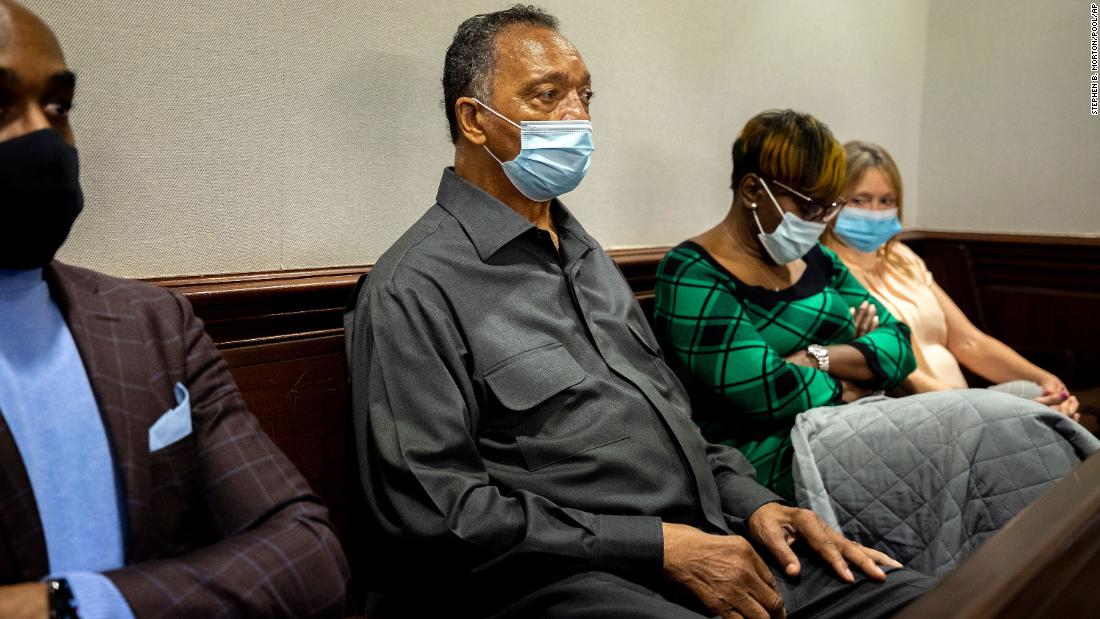The autopsy, performed by Georgia Bureau of Investigation medical examiner Edmund Donoghue, provided additional details of the shooting, which was captured on video taken by Bryan. Arbery and Travis McMichael can be seen in the video wrestling over the firearm before the shooting.
Arbery “died of multiple shotgun wounds sustained during a struggle for the shotgun,” Donoghue wrote in the autopsy report.
The shotgun blasts also damaged his right lung and fractured his upper left arm and scapula, according to the report.
In addition to malice and felony murder, the defendants also face charges of aggravated assault, false imprisonment and criminal attempt to commit a felony. All have pleaded not guilty. If convicted, each man could face life in prison without the possibility of parole.
Judge appears irked by defense attorney’s objections
“How many pastors does that Arbery family have? We had the Rev. Al Sharpton here earlier last week … I don’t know who Mr. Jackson, Rev. Jackson, is pastoring here,” Gough said.
“I guess the next question is which pastor is next? Is Raphael Warnock going to make, be the next person appearing this afternoon? We don’t know,” Gough said. “Your honor I would submit with all respect to the Rev. Jesse Jackson that his is not different than bringing in police officers or uniformed prison guards in a small town where a young Black man has been accused of assaulting a law enforcement officer or corrections officer.”
Warnock is a US Senator for the state of Georgia and a pastor at Ebenezer Baptist Church in Atlanta, the Rev. Martin Luther King Jr.’s former church.
The judge said the court’s position — not making any blanket rules over attendance as long as everyone is respectful in court — had not changed. “It’s almost as if you’re just trying to continue this for purposes other than just bringing it to the court’s attention,” he said.
Gough later asked for a mistrial, stating that his client had been deprived of his right to a fair trial. The two additional defense teams joined in the mistrial motion, which the judge denied.
As he ruled on the motion, Walmsley called some of Gough’s previous comments “reprehensible” and stressed to all the attorneys that their words were having an impact. He told them they needed to understand “that your words in this courtroom have an impact on a lot of what’s going on.”
Testimony reveals more details of shooting
Several investigators from the Georgia Bureau of Investigation provided information and analysis in testimony Monday.
Anne Kisler-Rao, a GBI crime lab staffer, testified that she analyzed fibers taken both from Arbery’s shirt and a tape lift from a truck.
Kisler-Rao said the fibers taken from the truck were “consistent” with the fibers from Arbery’s shirt, but said she could not say definitively if they came from the T-shirt Arbery was wearing.
Wanda Cooper-Jones, Arbery’s mother, closed her eyes during replays of the Bryan cell phone video, according to a pool reporter in the room. The jury kept their eyes on the video as each one was played.
Brian Leppard, a firearms and toolmark examiner for the GBI, testified he conducted a muzzle-to-target test after the state prosecutor’s office requested it. The test helped to determine the approximate distance between the end of the gun and the shirt Arbery was wearing. According to Leppard, his examination of the garment showed the tearing, searing and rolling around the holes in the shirt were consistent with contact or near contact firing from the weapon.
CNN’s Jason Hanna, Amir Vera, Joe Sutton, Jason Morris, Pamela Kirkland, Artemis Moshtaghian and Travis Caldwell contributed to this report.







More News
Analysis | More voters are identifying as Republicans. That could bode ill for Democrats in November.
Don Perlin, Comic Book Artist Who Found Success Late, Dies at 94
Simple, Summery, Spicy Grilled Shrimp